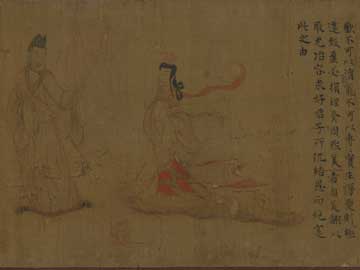In ten days time the British Museum will host an international academic conference devoted to one of the most remarkable objects in its collection: The Admonitions of the Instructress to the Court Ladies, which is the earliest known masterpiece of Chinese painting. Next Saturday, to coincide with that event, this rarely seen and exceptionally fragile painting will be placed on public display for the first time for many years. For reasons of conservation it will remain on view for only three weeks, before returning once again to the darkness of the museum stores.
Painted in ink on silk, the Admonitions scroll is the only surviving work of art attributed to the most celebrated master of the Period of Disunity, Gu Kaizhi (circa AD 345-406). In the words of Jane Portal, curator of Oriental Antiquities at the British Museum, the scroll “is generally regarded as the single most important Chinese painting in the world”. Eleven feet long and nine inches wide (a detail can only be shown here) the work offers a series of exquisite, tantalising glimpses of the great lost tradition of early Chinese painting – a tradition of which it is the sole remaining relic.
For more than a thousand years, Gu Kaizhi’s work has been viewed by connoisseurs and collectors of Asian art with an admiration bordering on awe. At the end of the roll of silk on which it was painted are attached a multitude of colophons, or notes of appreciation, written (as was long customary in China) by appreciative past owners. These include an extravagant eulogy written in 1746 by the hand of Ch’ien Lung, the famous Emperor, describing it as one of his greatest treasures. Among many other collectors’ seals printed on the roll are those of Sung Ch’I, eleventh century statesman, and Hui...

ITP 60: The Emperor Rebuffs ‘The Beautiful Wife Who Knew Herself to Be Beautiful’ attributed to Gu Kaizhi, from Admonitions of the Instructress to the Court Ladies
10-06-2001

